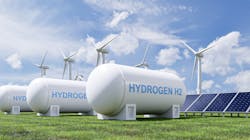DOE Announces $750 Million To Accelerate Clean Hydrogen Technologies
The U.S. Department of Energy has announced its intent to issue $750 million in funding from President Biden’s Bipartisan Infrastructure Law to dramatically reduce the cost of clean-hydrogen technologies. The funding is meant to play a vital role in supporting commercial-scale hydrogen deployment. Produced with net-zero carbon emissions, clean hydrogen is a key pillar in the emerging clean energy economy and will be essential for achieving the President’s goal of a 100% clean electrical grid by 2035 and net-zero carbon emissions by 2050.
Clean hydrogen—which is produced with zero or next-to-zero emissions from renewables, nuclear energy, or natural gas with carbon sequestration—is set to play a vital future role in reducing emissions from some of the hardest-to-decarbonize sectors of our economy, including industrial and chemical processes and heavy-duty transportation. Clean hydrogen can also support the expansion of renewable power by providing a means for long-duration energy storage and offers flexibility and multiple revenue streams to all types of clean power generation—including today’s nuclear fleet, advanced nuclear, and other innovative technologies. By enabling diverse, domestic clean-energy pathways across multiple sectors of the economy, hydrogen will strengthen American energy independence, resiliency, and security. While hydrogen technologies have come a long way over the last several years, costs and other challenges to at-scale adoption need to be addressed for clean hydrogen to realize its full potential.
Together with the regional clean hydrogen hubs (H2Hubs), tax incentives in the President’s Inflation Reduction Act, and ongoing research, development, and demonstration in the DOE Hydrogen Program, these investments will accelerate the technical advances and scale-up needed to achieve DOE’s Hydrogen Shot goal of $1 per kilogram of clean hydrogen within a decade.
Managed by DOE’s Hydrogen and Fuel Cell Technologies Office (HFTO), projects funded through this opportunity will address underlying technical barriers to cost reduction that can’t be overcome by scale alone and ensure emerging commercial-scale deployments will be viable with future lower-cost, higher-performing technology. Reaching cost reduction goals will open new markets for clean hydrogen—creating more clean energy jobs, reducing greenhouse gas emissions, and strengthening America’s competitiveness in the global clean energy market.
